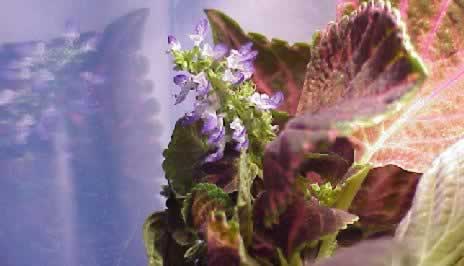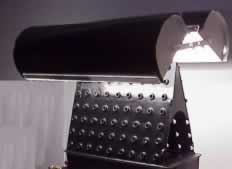Product Info
Plant Development is dependent on the specific spectrums
of the light source and the usable light energy
Only 37% of the energy in sunlight is within the wavelength
(colors) useful for photosynthesis, while 62.4% is infrared (thermal energy)
and the remaining 0.6% is ultraviolet. Photosynthesis in the plant leaf is
powered by 1% of the sunlight that falls on the plant, 10% of the sunlight
is reflected and 10% passes through the leaf. The leaf will retain 80% which
is used for transpiration. Some of the light is re-radiated, while the fraction
that remains is used for building food from the carbon dioxide, minerals and
water.1
|
Percent of
usable |
 |
|
|
Light
Spectrum Range
|
In artificial environments it is important to keep these factor in mind when programming the light source for the plants life cycle. According to our research for NASA, care should be taken to ensure that the plants grow under an artificial light source have adequate infra-red protection to prevent undue environmental stress for the plants.2 For the associated light spectrum consult your bulb's manufacturer (see below for some comparisons).
1. The
Solar Greenhouse Book
2. A Gravity-insensitive High-performance Aeroponic
System for Food Production in Space (1997 NASA SBIR Phase I Report - Aeroponics
International)
Usable Light Energy of Artificial Lighting compared
to Sunlight
Useable light energy for plant growth is measured in Micro-Einstein’s ( micro-mols of photons per meter squared per second). The sunlight reaching our plant is approximately 2,200 micro-Einstein’s on a cloud-less day and 170 micro-Einstein’s on a very cloudy day.
For indoor growing under artificial lighting a range of 200 to 500 micro-Einsteins is considered by experts at NASA to be minimal energy level for plant growth.
The higher the bulb wattage the further away the plant
must be from the light source to prevent environmental heat stress that can
cause the plant to transpire too quickly. Excessive transpiring can dehydrate
plants leading to wilting and poor growth. Likewise, the further the plant
is from the light source the less available useable energy is delivered to
the plant. The indoor grower most tune light energy resources as well
as other environmental variables for optimal growing conditions.

|
Criteria for maximizing the artificial light energy for photosynthesis
The indoor grower has several options for maximizing the artificial light energy for photosynthesis, they are as follows:
Aeroponics International has developed a high efficiency Light
System that meets the above criteria to deliver the optimum light energy
level to your plants.
Chart for Micro-Einsteins per watt of various types
of light bulbs
Below is a chart that can help you in determining the useable light
energy for your plants. For optimum usable energy for photosynthesis,
select a bulb that has the lowest wattage with the
highest usable energy coefficient with less than 1.5°F temperature
rise at 4 inches away from the light source.
Can your artificial light source do this?
Our LighArrays offers exceptional Micro-Einsteins out per watt (160 -240 watts)
 |
 |
More Light Array models - click here
Micro-Einstein
Bulb Comparisons
|
|
Distance:
|
Micro-Einsteins: Measured with a Quantum Meter |
Usable Energy Coefficient (micro-einsteins
per watt)
|
|
Incandescent
|
3
inches
|
310
|
3.100
|
|
Incandescent
|
6
inches
|
190
|
1.900
|
|
Incandescent
|
12
inches
|
65
|
0.650
|
|
Incandescent
|
18
inches
|
27
|
0.270
|
|
Incandescent
|
24
inches
|
18
|
0.180
|
|
Incandescent
|
36
inches
|
9
|
0.090
|
|
|
3
inches
|
1279
|
63.950
|
|
|
6
inches
|
413
|
20.650
|
|
|
12
inches
|
145
|
7.250
|
|
|
18
inches
|
122
|
6.100
|
|
|
24
inches
|
65
|
3.250
|
|
|
36
inches
|
32
|
1.600
|
|
Sodium
|
3
inches
|
250
|
1.000
|
|
Sodium
|
6
inches
|
99
|
0.396
|
|
Sodium
|
12
inches
|
30
|
0.120
|
|
Sodium
|
18
inches
|
14
|
0.056
|
|
Sodium
|
24
inches
|
10
|
0.040
|
|
Sodium
|
36
inches
|
7
|
0.028
|
|
Gro-Lite
|
3
inches
|
420
|
8.400
|
|
Gro-Lite
|
6
inches
|
135
|
2.700
|
|
Gro-Lite
|
12
inches
|
60
|
1.200
|
|
Gro-Lite
|
18
inches
|
31
|
0.620
|
|
Gro-Lite
|
24
inches
|
18
|
0.360
|
|
Gro-Lite
|
36
inches
|
9
|
0.180
|
|
Fluorescent
|
3
inches
|
52
|
1.300
|
|
Fluorescent
|
6
inches
|
36
|
0.900
|
|
Fluorescent
|
12
inches
|
13
|
0.325
|
|
Fluorescent
|
18
inches
|
7
|
0.175
|
|
Fluorescent
|
24
inches
|
5
|
0.125
|
|
Fluorescent
|
36
inches
|
2.5
|
0.063
|
Product Info:
Also see:
How to maintain a sterile environment for plant growth
Understanding Light Energy for Aeroponic Plant Growth
Aeroponic BenchTop Units for indoor growing
General Overview of Aeroponics
Tomato crops produced using Aeroponics
Trees and Shrubs Database Successfully propagated using Aeroponics
See the Component Descriptions of the above systems
Information on Aeroponic Growing
Biocontrol info:
BEYOND All Natural Plant Amendment™ Brochure
Purchase ODC / Beyond Biocontrols and Aeroponic Units and Systems
Use natural biocontrol products visit www.aeroponics.com